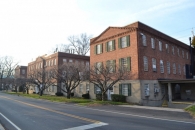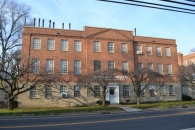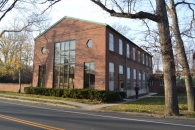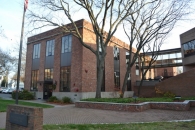Mill Record Norwalk
RETURN TO ‘FIND MILLS’Disclaimer: Content for these properties was compiled in 2014-2017 from a variety of sources and is subject to change. Updates are occasionally made under Property Information, however the Connecticut Trust for Historic Preservation (dba Preservation Connecticut) makes no representation or warranty that the information is complete or up-to-date.
- Complex Name (Common)
- R. T. Vanderbilt Co.
- Complex Name (Historic)
-
- R. T. Vanderbilt Co.
- Address or Location
- 30 & 31 Winfield Street, East Norwalk, Norwalk
- County
- Fairfield
- Historic Designation
- Associated Mill Community
- n/a

- Historic Information
Companies Associated w/Complex
- R.T. Vanderbilt Co. 1929-Present (2015)
Use (Historic)
Largest Documented Workforce
Unknown.
Historic Narrative
The R.T. Vanderbilt Company was organized in New York, New York in 1916 by Robert T. Vanderbilt, a resident of that city. Vanderbilt had secured sales contracts from several clay mines in the American South and organized his business with the intention of selling this resource to paper companies in the Northeast. Vanderbilt’s successful efforts in this endeavor led him to organize the Continental Clay Company (later the Dixie Clay Company) in 1917, the first of many subsidiaries set up by the firm in order to allow it to diversify and better take advantage of various markets. While Vanderbilt originally dealt in the sale of soft clays for the paper industry, the mining of hard clays used in rubber production soon took place under the Continental Clay Company. During the 1920s, the R.T. Vanderbilt Company established a research and development division that sought to investigate new uses for the clay and other minerals that the firm extracted and sold. R.T. Vanderbilt’s offices were originally located at 230 Park Avenue in New York, however, the company established both research and manufacturing facilities on Winfield Street in Norwalk during the 1920s. Work conducted by the firm led to numerous new proprietary products and processes during the 1920s, 1930s, and 1940s. These included the development of McNAMEE Clay, a paint pigment extender introduced in 1925; the first use of titanium dioxide as a paper and paint pigment in 1929; the development of VANSTAY, a vinyl stabilizer that made it a competitor to rubber in many applications, in 1935; and the introduction of VANCIDE, an agricultural bactericide and fungicide, in 1945. These products met with considerable success and the company’s Norwalk facilities were substantially expanded during this period. The firm also established a chemical plant in Bethel, Connecticut in 1950, and acquired a vacant plant on Hoyt Street in Norwalk in 1955. Further expansion during the middle of the 20th century included a new mining operation established in Gouverneur, New York in 1955; a new processing plant in Murray, Kentucky in 1969; and a new headquarters building on Winfield Street in Norwalk in 1974. The company remains headquartered in Norwalk and continues to serve the mineral, chemical, rubber, plastics, and petroleum markets through its research and development, extraction, and manufacturing divisions.
- Architectural Information
Number of Existing Buildings
Roughly eight (8) primary blocks.
Dates of Construction
1929, 1935, 1940, 1974.
Architect
Harrie T. Lindberg (1879-1959)
Builder
n/a
Building Type
Architectural Description
The R.T. Vanderbilt Company’s Norwalk facility is comprised of roughly eight primary adjoining and freestanding blocks located on the north and south sides of Winfield Street, immediately west of Winfield Street’s intersection with Stanley Street and Strawberry Hill Avenue. The oldest building associated with the complex is the main and central of five adjoining blocks located at the northeast corner of the facility. This is a three-story, Colonial Revival building which measures roughly 78’ x 48’. The building was built as a research laboratory and is of concrete block construction yet has a first story faced with cast stone blocks and upper stories faced with red brick. It has a concrete foundation, rectangular window openings with cast stone or brick sills and double-hung wood windows in either 12-over-12 or 8-over-12 arrangements, a modillioned red brick cornice, a red brick stepped parapet, concrete coping, and flat roof. The building’s symmetrical façade (south elevation) is eleven bays wide and has a projecting, three-bay central pavilion with a gabled red brick pediment rising into the parapet. The building’s primary entry is centered on the first floor of the façade and consists of a paneled wood pass-through door set in a molded wood surround and topped by a molded entablature. Metal lettering above the door reads, ‘R.T. VANDERBILT COMPANY, INC./RESEARCH DEVELOPMENT DIVISION.’ The research laboratory was enlarged in 1935 through the addition of identical wings adjoining its east and west elevations. Each wing consists of a three-story, 72’ x 32’ block linked to the central building by a one-story, 32’ x 48’ connecting block. The details of both wings are identical to those found on the respective floors of the main building. A three-story freestanding block was also erected on the north side of Winfield Street in 1935. This stands roughly 135’ west of the research laboratory and was used as a warehouse. The building is a two-story, 36’ x 74’ red brick block with a concrete foundation, large rectangular window openings, red brick stringcourses and cornices, and a front-facing gable roof. An additional research building was erected on the south side of Winfield Street in 1940. This is a two-story, 40’ x 150’ concrete block structure with a concrete foundation, red brick curtain walls, two-story rectangular window bays, a denticulated red brick cornice, red brick parapet, concrete coping, and a flat roof. This building originally stood immediately east of the first facility that the R.T. Vanderbilt Company acquired on Winfield Street, which had been built and occupied by the New England Cereal Company around 1905. This was demolished in 1974 when a new two-story headquarters building was erected by the company. The new offices are of Modernist design and measure roughly 136’ x 91’ overall. The building is of steel-frame and concrete construction and have concrete exterior wall panels, deeply recessed metal ribbon windows, and a flat roof.
Exterior Material(s)
Structural System(s)
Roof Form
Roof Material
Power Source
Condition
Fair
Condition Notes
The complex is in fair condition. Overall, the plant appears to be well maintained and structurally sound. The five blocks on the eastern side of the parcel identified as 31 Winfield Street (north side of Winfield Street) retain a very high degree of their historic fabric.
- Property Information
-
Specific Location
One legal parcel (30 & 31 Winfield Street) totaling 4.13 acres located on the north and south sides of Winfield Street, immediately west of Winfield Street’s intersection with Stanley Street and Strawberry Hill Avenue.
Adjacent To
n/a
Exterior Visible from Public Road?
Yes
Parcel ID / Assessor Record Link
Acreage
4.13
Use (Present)
- Sources
-
Form Completed By
Lucas A. Karmazinas
Date
12/11/2015
Bibliography
- List of Connecticut Manufacturers, 1922, 1924, 1930, 1932.
- Directory of Connecticut State Manufacturers, 1936, 1939.
- Industrial Directory of Connecticut, 1947.
- Register of War Production Facilities in Connecticut, 1951.
- Map of New Haven County; Clark, Richard, 1859.
- Atlas of New Haven County, Beers, Ellis & Soule, 1868.
- Aerial Survey of Connecticut, 1934, 1951, 1965, 1970, 1985.
- Sanborn Map Company, 1891, 1896, 1901, 1906, 1922, 1950, 1958.
- Norwalk Directory; Various editions.
- Hartford Courant, 1955, 1974.
- Norwalk; Grant, Lisa Wilson, 2014.
- R.T. Vanderbilt Co. Website.
- Representative View(s)Click on image to view full file








